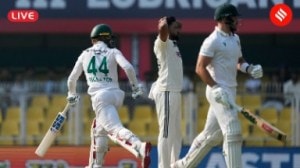Checkpoint of no returns
From Rs 57.53 crore in 1997-98 to Rs 10.65 crore in 2004-05. Indo-Myanmar border trade at Moreh is definitely down, reports Kartyk Venkatraman

THE tattered Indian tri-colour flapping at the head of the approach road to Border Immigration Checkpoint (Gate No 2), leading to the bustling Namphalong market in Myanmar, says it all. A far cry from the much-touted ‘‘land-bridge’’ for trade between India and South Asia. But if you are a numbers junkie, they spell it out more comprehensively. From a promising Rs 57.53 crore in 1997-98, to a dismal Rs 5.48 crore in 2000-01 to Rs 10.65 crore in 2004-05, Indo-Myanmar border trade at Moreh is definitely down.
If the numbers aren’t convincing, a stroll though this cosmopolitan town speaks volumes — locked out businesses, traders in the process of folding up and returning to the mainland, a derelict Trade Centre and loads of third-country goods. In the local shops, almost everything from soap to shoes to beer, is Chinese-made. And if it isn’t Chinese, it’s Thai.
The mention of the Indo-Myanmar border trade makes Chamber of Commerce president and Chennai-based businessman N. Kumar wince. Trade, he says, is at an all-time low. ‘‘In 1996, we were exporting about 150 truckloads of wheat flour (maida) per day to Myanmar. Last year, only 65 truckloads were sent. The flour is now supplied by China at a cheaper rate,’’ he says. Now, out of the 22 tradable commodities agreed on by both sides, India is exporting only soya bean nuggets, and importing only betel nut and dry ginger. The rest of the goods such as footwear, clothes, medicines, motorcycles, mosquito repellents — items that most would consider everyday stuff — are being traded illegally. The problem, says Kumar, is in the apparent lack of interest shown by both sides in the trade prospects.
‘‘Under the barter mechanism, imports and exports have to be balanced in three months. That isn’t happening.’’ Taking both legal and illegal export/import into consideration, Kumar estimates that Rs 30 lakh of goods are exported by India, while about Rs 80 lakh to Rs 1 crore worth of goods are imported. This, he says, is killing the local traders. The illegal trade, as per a senior government official dealing with border trade, is ‘‘nine times the legal trade’’.
‘‘We entered the Myanmar market too late. Now, Chinese and Thai goods have a stranglehold on the Myanmar market, and are cheaper than what we offer. Trade here is going on only for name sake. So many Tamil, Marwari and Punjabi traders have packed up and left.’’
According to traders here, what is needed urgently is for all relevant departments such as customs, excise etc to be under one roof, and not scattered as they are now. This, they say, will reduce documentation time hugely, and help legalise the trade. And, many more items need to be included in the tradable items list, ‘‘lungies’’ for a start as it is the common man’s attire in Myanmar and much in demand.
THE problem began when the bustling border market at Namphalong was shifted to Myanmar in the Nineties. Trader R Murthy says this has meant Indian vendors have no free access to the market, unlike Myanmarese traders who are selling everything from fresh vegetables to Chinese laptops. What is confusing them is the inaction by both sides, inspite of 11 years of trade since April 1995. Senior customs sources in Moreh say the bilateral trade agreement needs to be reviewed. Echoing the views of Moreh traders, they say the much talked about proposed Composite Checkpost will streamline trade. Moreover, it’ll be difficult for traders to evade any of the concerned departments.
Across the border in Tamu town, officials are inaccessible. But what is evident is that this border town isn’t dependent on Indian goods. While almost all automobiles, including two-wheelers, are Japanese, all the goods being sold in the neat, well-arranged shops are third-country. What is valuable, though, is Indian currency, which stands at Rs 100 for 800 Myanmar Kyets. And, the ‘‘lungies’’ are Indian.
IN Imphal, the commerce and industries ministry agrees that Indo-Myanmar trade is at an unprecedented low. According to State Minister for Commerce & Industries N Mangi Singh, his department has put forward some proposals to infuse life into the border trade during the visit of the Parliamentary Committee headed by MP Sushma Swaraj. These include discontinuing the barter mechanism and conducting trade through the mutually agreed system of freely convertible currencies; expansion of tradable commodities list and the letter of Credit (LC) facility to be set up between United Bank of India, Moreh and the Myanmar Economic Bank (MEB), Tamu. Necessary American dollar settlement accounts have been opened on both sides, and MEB staff have been trained by UBI, Kolkata. A hotline telephone facility between MEB and UBI and free movement of Myanmarese till Moreh to inspect Indian goods were other proposals.
While all this is still on paper, Moreh is hanging on to little more than reputation and a dwindling trader population. Biggies like Hindustan Lever, who were showing interest in the Nineties, have backed off. So have many other mainland India companies. Newcomers lose no time in scrapping trade plans once confronted with the constant bandhs and law and order situation.



- 01
- 02
- 03
- 04
- 05




























